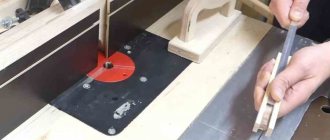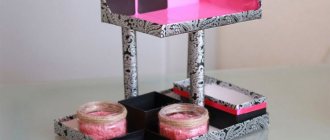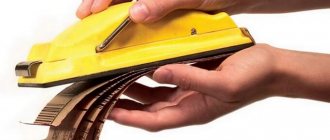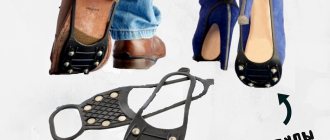Hello everyone, dear friends. This is rather my last article here, I think it will be interesting to many. I encountered the following problem: I needed to make an even circle in the plywood under the speakers, but there were no tools for this, this device was invented. The device is very simple, anyone can make it, and it is very easy to use.
For this “device” we need:
- a board 20-30 cm, thickness 2-3 cm - two self-tapping screws - a screwdriver - and something in which the hole will be made
You screw one screw into the middle of the board or a little closer to the edge, as convenient
Next, measure the required diameter, measure it on the board and mark it, screw in the second screw
This is roughly what it should look like
Now we screw the central screw through into the plywood, and slightly unscrew the second one so that its “sting” sticks out slightly from the board.
And we begin to rotate the board, thereby cutting through the board or whatever you call it
Each time, as soon as the board becomes easy to move, we screw the screw in a little inside, and thereby cut further and further into the circle
Here is the final result, the hole has already been cut, everything is perfectly smooth, if desired, you can sand it to give a smoother surface
That's all, we cut an even circle without any costs or special tools.
How to make a round hole in chipboard?
There are a couple of columns to be made, but I still haven’t learned how to cut with a jigsaw. Why does Caliber lead the file to the left? Fiolent is even stable in this regard. How can you make a hole for a speaker with a diameter of about cm. Using a jigsaw with a compass tool!
I just don’t know if there is such a device for the Chinese. A router, with a similar device, if you have a router. Well, actually, using a jigsaw is easiest. Just take a new file and cut without strong feed. If you have a milling machine, then you can use it. The set includes a special lever for circular cuts. And take a small finger cutter. Mill halfway on one side, then on the other. There are also special compass devices for drills.
Enough for 25 cm. But there you need a good stop for the drill, a stand is better. Again, if the chipboard is wide, then the depth of the cutter may not be enough. Then you can try it on both sides. In general, making good speakers is a great skill, incl.
I’m talking about your words - “but I never learned how to saw with a jigsaw.” I make it for myself, so any will be good. I don't have a router. Where to look for them, approximate cost. Such compasses are called “Device for cutting large diameter holes”, or a jig for drilling large diameter holes. In short, this is a special bushing with a drill shank and a cone for centering.
The bushing has a through hole across it into which a long rod is inserted. At the end of this rod there is a rectangular hole for the cutter with a screw for tightening. The diameter of the hole is adjusted by the position of the rod in the sleeve. Set it as needed and secure the rod in the bushing with a clamping bolt.
Well, actually drill. We have seen such devices many times in construction markets. That's where you need to look. This is not homemade, someone makes it on an industrial scale. If you need to make a careful selection for recessing the head flange, which is correct, and for HF it is absolutely necessary, then perhaps this is only with a router. As for the front panel, take Nickel's good advice. Also, a spacer in the case itself would not hurt, especially if it is large and the walls are thin, and the coating with vibration and sound absorbers. I did this.
Installation features
If you decide to install the plug yourself, then these simple instructions will help you understand the process:
- The location of the plug is determined. A mark is made on the table in the center of the future hole, which will serve as a guide. You can take a nail, place it on a point and lightly pierce the surface so that the drill does not slip on the countertop.
- Take a drill onto which a wood bit of the required diameter is installed . After this, the hole is drilled, everything is simple, the main thing is to place the centering drill exactly on the mark so as not to spoil the surface. During operation, ensure that the drill is in a vertical position.
The easiest way is to buy a set of crowns of different diameters so that you can easily choose the right option.
- The base of the plug is inserted into the hole . It snaps tightly into place due to the protrusions on the outside. It is necessary to carry out the work carefully so that the element stands up straight and does not deform due to excessive force.
- The wires are pulled, after which the cover is installed . It is better to do the work in this order, but, on the contrary, you can adjust the size of the hole if necessary.
How to cut a circle in plywood without a tool
Usually, in order to cut an even circle from a piece of plywood or board, craftsmen resort to various kinds of routers, use hand or electric jigsaws, and, at worst, take up a hacksaw. Meanwhile, with the help of a simple device, you can cut an absolutely even circle with a circular saw. How to do this in practice, read and see the detailed step-by-step instructions. Before cutting an even circle with a circular saw, make sure you have the necessary materials. You will need very little of the latter:. Step 1: Take a meter and measure the depth, length, and width of the groove on the working part of the table saw. Based on the obtained parameters, cut a block from a piece of plywood of suitable thickness. Step 2.
Instead of a compass
A school compass can also be useful in a home workshop, but its range of action is small. What if you need to draw a circle of large diameter?
An easy way is to do this with string, a nail and a pencil. The nail is carefully driven into the workpiece, the rope is secured to it at one end, and a pin is secured to the other end. The length of the rope determines the radius of the circle being drawn. The only condition is that the rope must be taut along the entire path of the pencil. Then the distance from the center (nail) to the circle in all sections of the marking will be the same.
Strip of cardboard or slats
An equally simple, but more reliable way is to use a strip of cardboard or, even better, a wooden plank instead of a rope. Drill two holes in this bar (strip) - one, smaller, for a nail, the other, larger, for a pencil. The distance between their tips should correspond to the radius of the desired circle. All that remains is to install the nail in the right place and rotate the bar around its axis.
Two sharpened nails and a wooden strip or a strip of thick cardboard can replace a compass.
Perfect circle using a jigsaw
Plywood, unlike other sheet materials, due to its dense and not loose structure, can be easily sawed out and obtained from it into various decorative complex shapes. Possessing a standard set of tools, any home craftsman is able to cut any desired, and even complex, elements from this material. However, in order for the blanks to have a marketable appearance and not interfere with the intended decorative element, you need to take into account some nuances when working with plywood. How to cut an even circle from plywood?
Drill sharpening
Drill bits may become dull with frequent use. You can sharpen the tool yourself or contact a specialist. If you decide to do this yourself and do not have the skills, it is better to practice on an old instrument. When sharpening, the main thing is not to violate the desired geometry and adhere to a certain degree. Sharpening can be done manually or on an electric machine.
- Metal analogues of drills are made of softer metal. They can be sharpened manually using a file.
- Using an electric machine, the drill overheats greatly. This can be avoided by constantly dipping it in water. Or organize a stream of water pouring onto the tip of the drill.
How to cut an even circle from plywood
Usually, in order to cut an even circle from a piece of plywood or board, craftsmen resort to various kinds of routers, use hand or electric jigsaws, and, at worst, take up a hacksaw. Meanwhile, with the help of a simple device, you can cut an absolutely even circle with a circular saw. How to do this in practice, read and see the detailed step-by-step instructions. Before cutting an even circle with a circular saw, make sure you have the necessary materials. You will need very little of the latter:.
Round corners of furniture
You can even get injured by hitting a sharp corner of the table. Therefore, we recommend cutting corners where possible. For homemade furniture, they need to be rounded from the very beginning.
Cutting circles and curved lines is no more difficult than making an absolutely straight cut on a workpiece, but under one condition: you have the right tool in your hands and you are good at it.
Mark missing parts
It may happen that the holes that you drilled to insert a narrow blade with a hand or electric hacksaw will end up in useful areas. To avoid such mistakes, you should mark all missing parts of the workpiece with shading.
What is suitable for the template
You can make a circle on a workpiece not only with a compass. Any object of a similar shape is suitable for this purpose. This could be a pan, plate, cup or bowl. However, when starting work related to the repair of furniture or some piece of furniture, calculate in advance the need for parts with rounded contours or with round holes. It may be enough to make only minor changes to the design.
How can you cut a circle with a jigsaw?
Plywood and, to a lesser extent, other sheet materials such as chipboard or oriented strand board have significant decorative potential. If you have a fairly simple tool and certain skills, you can cut almost anything out of plywood. But in order for the parts obtained as a result of such carving to look quite presentable, the master should have a few tricks in stock. We will talk about them in our article. Curvilinear cutting is difficult only at first glance. When starting to work with sheet materials, many craftsmen only have an idea of how to cut in a straight line. Therefore, the question of how to cut an even circle from plywood can confuse many. And indeed, a regular or circular saw cannot cope with the task.
Electric hacksaw
If you need to cut a round-shaped part and saw a round hole in the workpiece, then an electric hacksaw is the most suitable tool. With its help, you will save effort and time, since such a saw has great advantages over a manual one. Thus, the blade of the electric hacksaw is narrower, which provides increased maneuverability. Further, it has replaceable blades with different teeth, which allows you to process workpieces of any type, that is, wood, plywood, chipboard (it is no coincidence that the tool is also called a jigsaw).
To cut a section inside the workpiece, a hole is first drilled for a hand saw. But if you have an electric hacksaw, then this is not necessary. The tool is brought to the workpiece with a slight tilt forward and turned on in this position. The saw will cut the hole itself. Just don’t put too much pressure on the body - this can lead to breakage of the saw blade.
Lead in a circle
This device, simple in design, makes cutting out round holes or arcs much easier. It is enough to mark the center of the circle on the workpiece, fasten the device along the mark and connect the rod coming from it with an electric hacksaw. The divisions on the rod help set the saw blade at the required distance from the center of the circle. As a result, without preliminary marking, you can cut a circle or saw an arc with a radius of 5 to 20 cm.
The device (more precisely, its “sole”) is attached to the surface of the workpiece with screws. They should be well tightened. If the fastening is not rigid and starts to wobble, then an even circle will not work.
Suitable for lefties too
Left-handers can also use the device, since the guide rod is attached to the movable unit both on the left and on the right. So cut at your own discretion - clockwise or counterclockwise.
Using such a device, you can cut a round hole with a diameter of 10 to 40 cm in the workpiece without preliminary marking.
How can you cut a circle with a jigsaw?
VIDEO ON THE TOPIC: How to make a hole for a speaker with a drill
When working with different types of wood, you always need to know the detailed variations in its processing. Before you cut a circle in plywood, you need to know all the options, because you often have to adapt to the situation. There are many options for carrying out such an undertaking, and they differ radically. In order to cut a circle from plywood, you can use both professional tools and improvised means.
Peculiarities
First of all, it’s worth understanding the main features of plugs:
- May have different shapes and sizes . I will discuss the specific parameters below, but here I will only note that there are so many options that you can choose the ideal solution for any operating conditions and different numbers of wires. It is important to decide in advance on all the nuances in order to initially purchase a suitable modification, and not change one option to another later.
- The color design is also varied . Manufacturers make many options for different furniture colors so that you can find a solution that will match the table and fit organically into the overall design.
These are the main colors of the plugs, but there are also many less popular options
- The cable outlet looks very neat . In this case, the wires come out in the right place and you don’t have to think about how to pull them under the table or how to place them on the back side. It is important to ensure convenience when using various equipment, so the plugs are located where necessary for your situation.
Plugs allow you to stretch the wires in the optimal place and not worry about the appearance of the structure
- The cost of the elements is available to everyone . Of course, there are also expensive options, but most often the products are very cheap, which allows you to modernize furniture and lay wires at minimal cost. The cheapest are plastic options; they are most widespread these days and are widely used both in offices and apartments.
- Installation is not difficult . If desired, almost anyone can install the plug; this will require a simple set of tools and minimal skills in working with them. I will discuss all the features of the process in the next section.
Installing an element into a countertop is much easier than it seems at first glance
- The plug is made so that the cover with the hole for the wires rotates around its axis . This allows you to place it in the optimal position so that the cable is not pinched and is positioned correctly. Additionally, you can adjust the size of the hole to accommodate the amount of wire you need to run through.
- The design is very simple and consists of two elements : a base built into the tabletop, and an upper movable part with locks, which rotates in the body and can be quickly removed if necessary. There are no complex components, so the products are reliable and durable.
Simplicity of design ensures reliability and durability of products
How and with what to cut out curves and circles
There are a couple of columns to be made, but I still haven’t learned how to cut with a jigsaw. Why does Caliber lead the file to the left? Fiolent is even stable in this regard. How can you make a hole for a speaker with a diameter of about cm. Using a jigsaw with a compass tool!
Plywood (and to a lesser extent other sheet materials such as chipboard or oriented strand board) has significant decorative potential. If you have a fairly simple tool and certain skills, you can cut almost anything out of plywood. But in order for the parts obtained as a result of such carving to look quite presentable, the master should have a few tricks in stock. We will talk about them in our article.
Curvilinear cutting is difficult only at first glance
Types of stubs and aspects of their selection
First, let's look at the main varieties, and then I will tell you about the important features that affect both the quality and appearance of the products. Use the information in this section to find the perfect solution for your home or office.
Main varieties
All options on the market can be divided into several groups:
| Illustration | Description |
| Round plugs are the most popular option and are the most common . They can have different diameters, most often there are modifications from 35 to 80 mm, the size is determined by the hole that needs to be drilled for installing the element. |
The design of the top cover also differs; the simplest models, as in the photo, are equipped with sliding segments that adjust the size of the hole; better options use special curtains or a brush through which it is easy to pull wires, but dust does not penetrate inside.
Such structures must be positioned correctly so that it is convenient to pull the wires in both directions.
Material of manufacture
There are several main options:
| Square options . This variety is distinguished primarily by its shape and is more suitable for modern environments. Most often, the elements have a size of 80x80 mm, although there are other varieties. The design is simple, the slot for the cable is placed on the side convenient for you, the hole is closed with a special brush to prevent dust from getting inside. | |
| Rectangular models . An ideal solution for situations where you need to run a large number of wires through the tabletop. Most often, such designs are used in offices and are placed on several computers at the same time in large tables, at which several people sit. Dimensions may vary and are selected for specific operating conditions to ensure the required throughput. | |
| Rectangular double-sided plugs . This option is intended for tables that accommodate two computers; thanks to the design, the wires are laid freely in the desired direction and it looks neat and attractive. | |
| Oval plugs . This solution is different in shape and has an interesting design of the top cover, which allows you to adjust its position depending on the number of wires that are laid. | |
| Rectangular modules for built-in sockets. Now there are options in which several sockets are hidden under the cover of the plug; there may also be telephone and network plugs, which is very convenient. Such options are expensive, but they allow you to place everything you need on the table and not have to put a lot of sockets in the room. This is an office option, under which you will have to lay a cable channel along the bottom of the countertops. |
| Illustration | Description |
| Plastic . The most popular solution with a number of advantages: |
- Low cost, products are cheaper than any other analogue.
- A huge variety of colors allows you to choose the optimal solution for any table.
- The reliability of the material, plastic is not afraid of moisture, retains its appearance for a long time and has plasticity. Of the minuses, the only thing that can be highlighted is that it is not the most presentable appearance.
Most often, the surface is covered with a special coating for chrome, bronze or other metals. The layer performs both a decorative and protective function, preventing corrosion. Moreover, it can be either a gloss or a matte surface.
If you need a moisture-resistant option, you can find stainless steel plugs; they are the most expensive, but also the most reliable.
Cutting Tips
Selecting a tool
When starting to work with sheet materials, many craftsmen only have an idea of how to cut in a straight line. Therefore, the question of how to cut an even circle from plywood can confuse many. And indeed, a regular or circular saw cannot cope with the task. Figure cutting is most often done using the following tools:
Hand jigsaw
- Hand jigsaw. The simplest device used for sawing. With the help of a jigsaw, even the most delicate work can be done with your own hands, but for thick material or long cuts it is practically not suitable.
- Jigsaws. There are two types of devices you can use here:
- regular, with a vertical file;
- artistic, in which the role of the cutting element is performed by a steel blade.
Ordinary jigsaws will come in handy when working with thick plywood, for example, when making a bed with your own hands. But if you are looking for a way to cut letters out of plywood or make other complex elements (for example, parts of a children's construction set), then it is best to use a model with a band saw. Model for artistic cutting
Advice! Naturally, for each type of jigsaw there are several types of files and blades. The correct choice of cutting element is a necessary condition for high quality of the product.
- In addition to jigsaws, you can use a furniture router for curved cutting. Despite how difficult it is to operate, it is many times superior to most models of plywood saws in terms of the quality of the holes it makes. Using a router, you can make a wonderful rocking chair from sheets of plywood with your own hands.
Conclusion
Now you know about all the features of plugs for wires on the table and you can choose the best option yourself, and if you wish, install it without any problems. The video will help you better understand some aspects, and if you have questions, write them in the comments under the review.
Cutting round holes in plywood
Often, when repairing or installing various wooden products, it is necessary to drill a perfectly round hole. In this article we will try to highlight all the ways in which such a hole can be cut. Options with the use of special tools, as well as without them, will be considered.
How to cut plywood
A hacksaw with a very narrow blade, a jigsaw, a drill saw and a round file are among the hand tools that can be used to cut curves.
It is the narrow blade that provides maneuverability to the hacksaw, but for the same reason it is extremely difficult to operate. You must have a steady hand and an attentive eye to prevent deviations from the markings. However, do not try to work quickly. On the contrary, it is better to advance in small spurts. This will help you hold the saw handle more confidently and guide it exactly along the given line.
It is better to cut out small round or oval holes and “narrow” curves using special tools - a drill saw and a round file, which can also be used to clean out curves.
However, the most suitable tool for cutting rounded parts and holes is an electric hacksaw. Its advantage is not only that it saves energy and time. The included set of interchangeable blades with different teeth allows you to choose a blade for sawing almost any type of workpiece, be it wood, plywood or chipboard. In other words, an electric hacksaw can rightfully be called a universal tool.
Shape cutting technologies
Jigsaw
As we noted above, a jigsaw will come in handy if we are looking for how to cut a word out of plywood or make other parts of complex shapes:
- We transfer pre-printed drawings or templates onto the workpiece using carbon paper.
Figured carving with a jigsaw: photo of the finished product
- If the structure has through sections, we make starting holes with a thin drill.
- Insert a file or jigsaw blade into the hole. Secure the free end of the file with a fastening screw or clamp.
- We make a cut along the intended line, pressing the workpiece to the workbench. The saw moves either automatically (for electric jigsaws) or manually.
After all the arc elements have been sawn, we remove unnecessary areas and process the finished part with a file or sandpaper.
Finished hole
Fraser
A furniture router is great for cutting out thick plywood. Of course, you can’t make a complex shape with it, but cutting an arc or circle is easy:
- We fix the standard ruler included in the router in the center of the circle using a self-tapping screw.
- If the length of the ruler is not enough, you can assemble a simple bracket from a metal profile or wooden planks.
- By rotating the cutter along a fixed radius, we select a groove along the circumference, resulting in an almost perfect hole.
Bracket for router: with it you can cut a disc of almost any diameter
Note! When calculating the diameter of the circle, you should take into account the dimensions of the working cutter. The instructions for the device will tell you the exact numbers.
In this way, you can cut not only circles, but also individual arcs - for example, in order to make grooves for furniture brackets.
Using improvised means
For shaped elements, it is advisable to have special devices, but any craftsman may need to make a round hole in a slab of laminated veneer. Below we will tell you how to cut a circle from plywood when you have nothing at hand. Well, almost nothing:
- To cut plywood, use a wooden strip with two nails.
- One nail is driven through the strip into the workpiece, exactly in the center of the hole being made.
- We drive the second nail into the bar so that the point protrudes on the wrong side by at least 5-10 mm. The distance from the first nail should be equal to the radius of the hole being made.
- Rotating the bar, use the tip to draw a groove on the plywood, deepening it with each turn.
- Instead of a stick, you can use a strong cord. The operating principle remains unchanged.
Diagram of "threading" using nails. The sharper the nail used, the faster the hole will be made. It should be noted that although the price of such a device is low, it is worth using it only when other methods are not available: the edges still turn out to be far from ideal.
Drill saw
Neither a hand saw nor an electric hacksaw will help if you need to cut a small hole in the workpiece - less than 10 cm in diameter. A jigsaw may also be useless if the workpiece is large. In this case, the most suitable tool is a drill saw. With its tip it bites into the wood like a drill and thus makes a “starting” hole for further cutting. Externally, the saw is similar to a round file with the difference that its shaft is surrounded by a spiral around the cutting edge.
Drill saws are available with interchangeable attachments of various diameters, designed for processing both soft and hard wood, as well as a variety of materials made from it.
The working body of a drill saw is a metal rod with a cutting tip, like a gimlet, and a cutting edge that goes around the rod in a spiral.
This is what the narrowest of hand saws looks like. Thanks to the fastening unit, the blades in the hacksaw can be changed depending on the nature of the material being processed.
Drill attachment
One of the most popular and convenient options for cutting a hole is a special attachment for a drill. It is made in the form of a crown comb and has a rounded shape. With this attachment, cutting holes occurs quickly, and they turn out quite smooth.
drill bit for holes
Nozzles come in different diameters, which allows you to cut a hole of the required diameter. If you have already prepared a hole, we can advise you to try your hand at options trading.
Drill
You can also cut a large hole using a drill. To do this, it is necessary to pre-mark the outline of the hole to be drilled. Next, use a small drill to drill through holes along the contour prepared in advance. Next, using a jigsaw or a very sharp knife, we cut off the holes, thereby connecting the holes. After which you can smooth the circle using sandpaper of various grain sizes.
Read also: What is laser cutting on wood
Chisel
You can also cut the required hole using a chisel. It is enough to remove the wood layer by layer along the contour. This option is the least suitable for interior decoration. The hole must be smooth, which cannot be achieved by using improvised and unsuitable materials for the job. The best option would be to use a drill bit. The hole is even and has smooth edges.
Thus, to summarize, it becomes clear that you need to choose a tool for cutting a hole based on your goals. If you need a high-quality cut, then you cannot do without a special tool.
As it turns out, not many people know that you can easily cut a perfectly round hole of any diameter in plywood.
And I decided to share this method with you.
To do this we need a piece of rail and two self-tapping screws.
Divide the diameter of the future hole in half and put two marks on a piece of wood.
Then we drill according to the marks.
And screw both self-tapping screws into the drilled holes so that their ends protrude by 5-8 mm.
Now we align the first tip of the self-tapping screw to the center, and with the second, applying a little force, rotate it around the axis
Having reached the middle of the thickness of the plywood, we turn it over and perform the same operation. Don't worry about the center getting lost. Scrolling in place, the central self-tapping screw drilled a hole.
Using the example of a piece of krages, you were convinced that it is not so difficult to cut out a perfect circle without special tools.
In this way I cut holes in 10 mm thick plywood.
And of course, in the video you can watch the whole process in detail.
BEING THE AUTHOR OF THIS ARTICLE, I PROHIBIT COPYING TEXT, PHOTO AND VIDEO MATERIAL FROM THIS SITE TO OTHERS.
Installation features
If you decide to install the plug yourself, then these simple instructions will help you understand the process:
- The location of the plug is determined. A mark is made on the table in the center of the future hole, which will serve as a guide. You can take a nail, place it on a point and lightly pierce the surface so that the drill does not slip on the countertop.
- Take a drill onto which a wood bit of the required diameter is installed . After this, the hole is drilled, everything is simple, the main thing is to place the centering drill exactly on the mark so as not to spoil the surface. During operation, ensure that the drill is in a vertical position.
The easiest way is to buy a set of crowns of different diameters so that you can easily choose the right option.
- The base of the plug is inserted into the hole . It snaps tightly into place due to the protrusions on the outside. It is necessary to carry out the work carefully so that the element stands up straight and does not deform due to excessive force.
- The wires are pulled, after which the cover is installed . It is better to do the work in this order, but, on the contrary, you can adjust the size of the hole if necessary.
Wires are routed the way you need them
If you have a square or oval plug, you will have to use a jigsaw rather than a crown to cut the hole.
Templates
Shot glasses, cups, plates, pots or baking dishes - in any household there are many round-shaped objects that can be used to mark a circle. If you are making something and decide to give your product a rounded shape, then first look to see if there is a suitable template among the household utensils. To be sure, select a few items and take them to the workshop. There you can immediately try them on the workpiece and determine what is most suitable. With some practice, you will be able to make rounded lines from several round objects with different radii. Arcs of a circle can be drawn sequentially, or bridges-transitions can be made between individual arcs.
Preliminary drawing
Before attempting to trace a curve on a piece of paper, design it on a large piece of paper or piece of corrugated cardboard. Only after the result is satisfactory in all respects can you cut out a template from paper and make markings on it on the workpiece.
You can draw circles and fragments of a circle using a cup or plate by simply tracing them with a pencil.
Types of stubs and aspects of their selection
First, let's look at the main varieties, and then I will tell you about the important features that affect both the quality and appearance of the products. Use the information in this section to find the perfect solution for your home or office.
Main varieties
All options on the market can be divided into several groups:
| Aluminum . A modern solution with an attractive appearance and good performance characteristics. Aluminum products weigh little, retain an attractive appearance for a long time, but are also much more expensive than standard plastic. | |
| Steel . Another metal option, which is strong and durable and at the same time costs significantly less than its aluminum counterparts. |
| Illustration | Description |
| Round plugs are the most popular option and are the most common . They can have different diameters, most often there are modifications from 35 to 80 mm, the size is determined by the hole that needs to be drilled for installing the element. |
The design of the top cover also differs; the simplest models, as in the photo, are equipped with sliding segments that adjust the size of the hole; better options use special curtains or a brush through which it is easy to pull wires, but dust does not penetrate inside.
Such structures must be positioned correctly so that it is convenient to pull the wires in both directions.
Material of manufacture
There are several main options:
| Square options . This variety is distinguished primarily by its shape and is more suitable for modern environments. Most often, the elements have a size of 80x80 mm, although there are other varieties. The design is simple, the slot for the cable is placed on the side convenient for you, the hole is closed with a special brush to prevent dust from getting inside. | |
| Rectangular models . An ideal solution for situations where you need to run a large number of wires through the tabletop. Most often, such designs are used in offices and are placed on several computers at the same time in large tables, at which several people sit. Dimensions may vary and are selected for specific operating conditions to ensure the required throughput. | |
| Rectangular double-sided plugs . This option is intended for tables that accommodate two computers; thanks to the design, the wires are laid freely in the desired direction and it looks neat and attractive. | |
| Oval plugs . This solution is different in shape and has an interesting design of the top cover, which allows you to adjust its position depending on the number of wires that are laid. | |
| Rectangular modules for built-in sockets. Now there are options in which several sockets are hidden under the cover of the plug; there may also be telephone and network plugs, which is very convenient. Such options are expensive, but they allow you to place everything you need on the table and not have to put a lot of sockets in the room. This is an office option, under which you will have to lay a cable channel along the bottom of the countertops. |
| Illustration | Description |
| Plastic . The most popular solution with a number of advantages: |
- Low cost, products are cheaper than any other analogue.
- A huge variety of colors allows you to choose the optimal solution for any table.
- The reliability of the material, plastic is not afraid of moisture, retains its appearance for a long time and has plasticity. Of the minuses, the only thing that can be highlighted is that it is not the most presentable appearance.
Most often, the surface is covered with a special coating for chrome, bronze or other metals. The layer performs both a decorative and protective function, preventing corrosion. Moreover, it can be either a gloss or a matte surface.
If you need a moisture-resistant option, you can find stainless steel plugs; they are the most expensive, but also the most reliable.
Peculiarities
First of all, it’s worth understanding the main features of plugs:
- May have different shapes and sizes . I will discuss the specific parameters below, but here I will only note that there are so many options that you can choose the ideal solution for any operating conditions and different numbers of wires. It is important to decide in advance on all the nuances in order to initially purchase a suitable modification, and not change one option to another later.
- The color design is also varied . Manufacturers make many options for different furniture colors so that you can find a solution that will match the table and fit organically into the overall design.
These are the main colors of the plugs, but there are also many less popular options
- The cable outlet looks very neat . In this case, the wires come out in the right place and you don’t have to think about how to pull them under the table or how to place them on the back side. It is important to ensure convenience when using various equipment, so the plugs are located where necessary for your situation.
Conclusion
Now you know about all the features of plugs for wires on the table and you can choose the best option yourself, and if you wish, install it without any problems. The video will help you better understand some aspects, and if you have questions, write them in the comments under the review.
| Aluminum . A modern solution with an attractive appearance and good performance characteristics. Aluminum products weigh little, retain an attractive appearance for a long time, but are also much more expensive than standard plastic. | |
| Steel . Another metal option, which is strong and durable and at the same time costs significantly less than its aluminum counterparts. |











